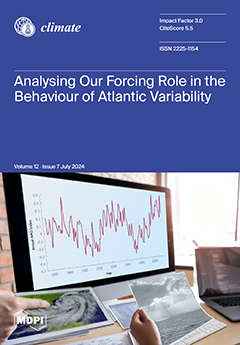Open AccessArticle
Small Municipalities in the Amazon under the Risk of Future Climate Change
by
Everaldo B. de Souza, Brenda C. S. Silva, Emilene M. F. Serra, Melgris J. Becerra Ruiz, Alan C. Cunha, Paulo J. P. O. Souza, Luciano P. Pezzi, Edson J. P. da Rocha, Adriano M. L. Sousa, João de Athaydes Silva, Jr., Alexandre M. C. do Carmo, Douglas B. S. Ferreira, Aline M. M. Lima, Flavio A. A dos Santos, Bergson C. Moraes, Maria de L. P. Ruivo, Peter M. Toledo and Tercio Ambrizzi
Cited by 8 | Viewed by 3560
Abstract
The focus of this work is on small municipalities (population below 50 thousand inhabitants) that cover around 87% of the territory of the Brazilian Legal Amazon (BLA). Based on a comprehensive integrated analysis approach using the three components hazard (climate extremes from CMIP6
[...] Read more.
The focus of this work is on small municipalities (population below 50 thousand inhabitants) that cover around 87% of the territory of the Brazilian Legal Amazon (BLA). Based on a comprehensive integrated analysis approach using the three components hazard (climate extremes from CMIP6 future scenarios), exposure (directly affected population), and vulnerability (subdimensions of susceptibility and coping/adaptive capacity by using multidimensional indicators), the latter two using current datasets provided by the official Census IBGE 2022, we document a quantitative assessment of the risk R of natural disasters in the BLA region. We evidenced a worrying and imminent intensification of the curve of R in most Amazonian municipalities over the next two 25-year periods. The overall results of the highest proportions of R (total municipalities affected) pointed out the Amazonas, Roraima, Pará, and Maranhão as the main states, presenting projected categories of R high in the near future (2015 to 2039) and very high in the far future (2040 to 2064). The detailed assessment of the susceptibility and coping/adaptive capacity allowed us to elucidate the principal indicators that aggravate the degree of vulnerability: economy, the precariousness of urban infrastructure, medical services, communication, and urban mobility, whose combined factors, unfortunately, reveal a widespread poverty profile along the small Amazonian municipalities. Our scientific findings can assist decision makers in targeted strategies planning and public policies to minimize and mitigate ongoing and future climate change.
Full article
►▼
Show Figures





